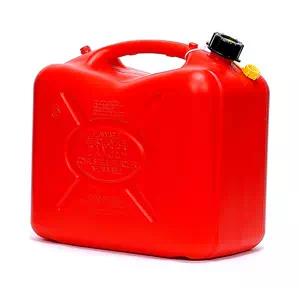|

Overview
EPA established standards that limit hydrocarbon emissions that evaporate from or permeate through portable fuel containers (PFCs) such as gas cans used to refuel a wide variety of gasoline-powered equipment (e.g., lawn and garden equipment, recreational equipment, and passenger vehicles that have run out of gas). The rules apply to PFCs manufactured after January 1, 2009. The rule also applies to importers.
The standards limit evaporation and permeation emissions from these containers to 0.3 grams of hydrocarbons per gallon per day. EPA also adopted test procedures and a certification and compliance program to ensure that containers meet the emission standard over a range of in-use conditions.
During rulemaking, EPA worked closely with major container manufacturers to help assure that the new cans will be built with a simple and inexpensive permeation barrier and new spouts that close automatically.
| Vents are Back. On July 24, 2025, EPA issued letters to portable fuel container manufacturers encouraging them to add vents to gas cans to ensure safe and effective refueling. This announcement comes in response to years of complaints about slow, frustrating fuel flow from modern gas cans. With this reminder to manufacturers to incorporate self-closing vented designs, EPA wants to help make it easier and faster for Americans to refuel. |
Purpose of the Regulations
In 2008 there were an estimated 3.27 billion gallons of fuel dispensed by over 80 million PFCs in the United States that resulted in an estimated 70,262 gallons of spilled fuel annually.
The danger of spilled fuels comes in the form of VOCs (volatile organic compounds) that escape into the atmosphere whenever gas leaves a container. The regulations focus on VOCs ability to permeate through the plastic of the container and emissions released when pouring or caps are left off. VOCs are considered a greenhouse gas and their release can also contaminate ground water.
PFC Regulations
The EPA regulations are based on requirements started in California by the California Air Resources Board (CARB) in 2000 and updated in 2007. Since 2000, some individual states have been following suit, but the EPA regulations bring all states in line -- since January 1, 2009 all new PFCs manufactured or imported and sold in the United States must be compliant.
The regulations require:
-
A treated can body for minimal permeation of fuels.
-
Automatic closure, meaning a nozzle which automatically springs to the closed position when not pouring.
-
Childproof features as designated by the Children's Gasoline Burn Prevention Act.
The full text of the PFC regulations is found in 40 CFR 59.600 through 40 CFR 59.699.
Requirements for Importing Portable Fuel Containers into the United States
The requirements for importing portable fuel containers into the US are found in 40 CFR 59.644.
In addition to meeting the technical specifications, prior to importing containers into the U.S., EPA may require an importer to post a bond (up to five dollars per container) to cover any potential compliance or enforcement actions under the Clean Air Act if an importer cannot demonstrate to EPA that they have assets of an appropriate liquidity readily available in the United States with a value equal to the retail value of the containers that will be imported during a calendar year.
Additional Resources
What are the requirements for importing portable fuel containers.
Portable Fuel Container and Equipment Manufacturer Contacts List maintained by the California Environmental Protection Agency.
|
